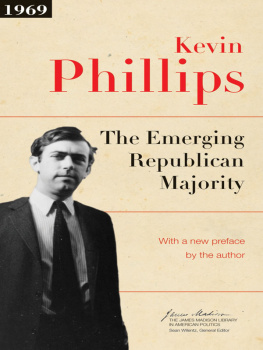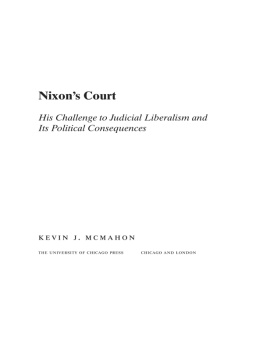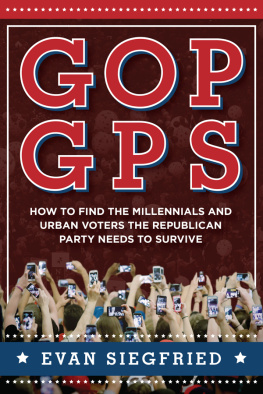
The Emerging Republican Majority

THE JAMES MADISON LIBRARY IN AMERICAN POLITICS
Sean Wilentz, General Editor
Margot Canaday, Kevin M. Kruse, Julian E. Zelizer, series advisory board members
The James Madison Library in American Politics of the Princeton University Press is devoted to reviving important American political writings of the recent and distant past. American politics has produced an abundance of important worksproclaiming ideas, describing candidates, explaining the inner workings of government, and analyzing political campaigns. This literature includes partisan and philosophical manifestos, pamphlets of practical political theory, muckraking expos?s, autobiographies, on-the-scene reportage, and more. The James Madison Library issues fresh editions of both classic and now-neglected titles that helped shape the American political landscape. Up-to-date commentaries in each volume by leading scholars, journalists, and political figures make the books accessible to modern readers.
The Conscience of a Conservative by Barry Goldwater
The New Industrial State by John Kenneth Galbraith
Liberty and the News by Walter Lippmann
The Politics of Hope and the Bitter Heritage: American Liberalism in the 1960s by Arthur M. Schlesinger, Jr.
Richard Nixon: Speeches, Writings, Documents, edited and introduced by Rick Perlstein
The Emerging Republican Majority, by Kevin Phillips
The Emerging Republican Majority
Kevin Phillips
With a new preface by the author
PRINCETON UNIVERSITY PRESS
PRINCETON AND OXFORD
Copyright 2015 by Kevin P. Phillips
General Editors introduction 2015 by Sean Wilentz
Original edition published by Arlington House, New Rochelle, New York
Requests for permission to reproduce material from this work should be sent to Permissions, Princeton University Press
Published by Princeton University Press, 41 William Street, Princeton, New Jersey 08540
In the United Kingdom: Princeton University Press, 6 Oxford Street, Woodstock, Oxfordshire OX20 1TW
press.princeton.edu
Cover photograph courtesy of the author
First edition, 1969
Paperback edition with corrrections and preface, 1970
The James Madision Library in American Politics edition, 2015
All Rights Reserved
Phillips, Kevin, 1940
The emerging Republican majority / Kevin P. Phillips.
pages cm. (The James Madison library in American politics)
Includes bibliographical references and index.
ISBN 978-0-691-16324-6 (paperback)
1. Republican Party (U.S. : 1854 ) 2. United StatesPolitics and government. I. Title.
JK2357.P55 2014
324.2734dc23 2014014924
British Library Cataloging-in-Publication Data is available
This book has been composed in Sabon
Printed on acid-free paper.
Printed in the United States of America
10 9 8 7 6 5 4 3 2 1
This book is respectfully dedicated to the emerging Republican majority and its two principal architects: President Richard M. Nixon and Attorney General John N. Mitchell.
Contents
General Editors Introduction
American politics, or at least mainstream party politics, generally does not advance in line with manifestos, programs and systematic political analyses. But now and then, a single publication seems to capture a change in the direction of American politics just as it is occurring. Kevin Phillipss The Emerging Republican Majority is one of those rarities.
To be sure, as Phillips explains in the introduction to this new James Madison Library edition, much of the original commotion about the book was misplaced. Seeking to make sense of what many considered Richard M. Nixons improbable victory amid the turmoil of 1968, pundits from across the political spectrum seized on Phillipss examination as some sort of master plan, from which the GOP had supposedly drawn what was already becoming known as its Southern Strategy. In truth, Phillips was barely involved in the larger planning of that legendary race. During the late stages of the 1968 campaign, he proffered timely advice based on his findings that proved helpful to Nixons strategists, but he always functioned more as an observer of politics than a political operative. The Emerging Republican Majority did not design the shift to conservatism in 1968 as much as it described that shifts long- and short-term origins.
Phillipss work offered a dazzling account, filled with charts and other data, of how and why the national coalition that elected Franklin D. Roosevelt in 1932 and then sustained the New Deal had unraveled over the previous quarter century. Then the book explored that unravelings profound implications. It was less a blue-print for victory than a topographical map of the changed political terrain of the late 1960s. In providing that map, the book served as a harbinger not of particular events but of the major trends that led to a conservative political era, one that in the 1980s brought the advent of President Ronald Reagana leader who embodied the transfiguration of the New Deal majority.
It is difficult to convey how much Phillipss conclusions ran against the grain of the conventional political wisdom of the 1950s and 1960s. It was a time when scholars and pundits alike were expounding upon a great liberal consensus in American politics. Despite brief outbursts of conservative and even right-wing furythe latter exemplified by the rise of Senator Joseph McCarthythe New Deals basic principles of active government appeared to have triumphed. The most successful Republicans in national politics were moderates, above all President Dwight D. Eisenhower, who campaigned and then governed in the name of what became known as Modern Republicanism. Even in opposition, the GOP appeared to have become reconciled to many of the institutional innovations implemented by Franklin D. Roosevelt and the Democrats during the 1930s, notably Social Security.
In 1964, dissident conservatives and right-wingers, having captured the GOP party machinery, nominated Barry Goldwater for the presidency. Mocking what they beheld as the moderate and liberal Republican establishment, the Goldwater forces promised that they would offer the voters a choice, not an echo. Yet the electorate handed Goldwater one of the worse shellackings in the history of American presidential politics. As the victor Lyndon B. Johnson and his administration geared up to redouble the New Deal with Johnsons Great Society programs, civil rights reforms and War on Poverty, claims about the liberal consensus seemed vindicated. It appeared as if the forward march of liberal politics would never end.
In 1966, however, a stunning Democratic debacle in the midterm elections brought the conventional wisdom up short. Some found the ferocity of the backlash difficult to explain, but others pointed out how acrid the political climate had become in just two years, amid escalation of the American military effort in Vietnam, rioting in urban black ghettoes, Johnsons declining popularity and a general souring by the public on ambitious liberal reform. Phillipss figures, though, not only accounted for the sudden reversal; they also showed how a new national political configurationits foundations in a region stretching from Florida to California that Phillips dubbed the Sun Belthad been taking shape for many years. That configuration would twice elect Richard Nixon to the White House; it would then survive Nixons disgrace in Watergate and in time become the foundation for a Reagan Republican ascendancy that lasted (by Phillipss own reckoning) until 1992.
Next page









